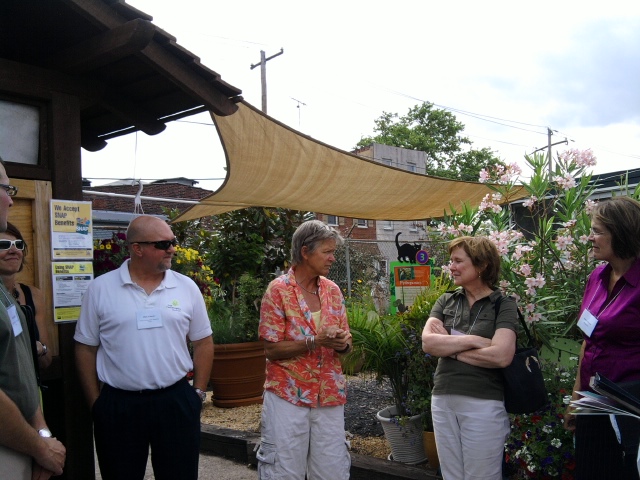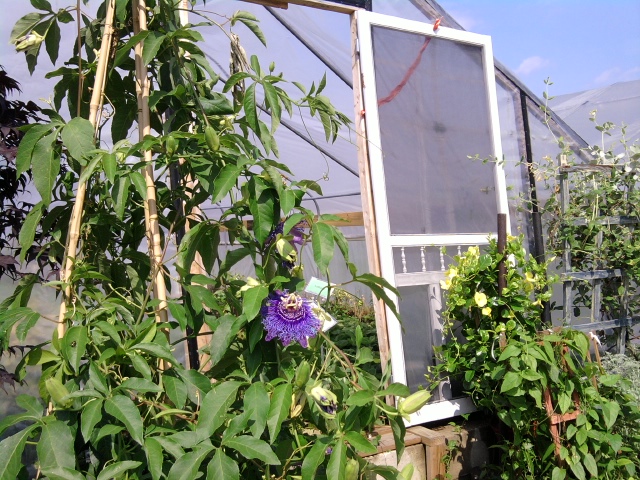Other cities come here to see how PHS does it
Reginald Walton, who had traveled from Indianapolis, stood beneath a tree at a large, grassy property a couple of blocks from the Temple University train station, listening as leaders from the Pennsylvania Horticultural Society and the Asociacion Puertorriquenos en Marcha, Inc. told the story of its transformation.
This space on Berks Street, abandoned by its former owners, had been a dumping ground. But ever since PHS cleaned it up, planted it with grass and trees, and installed a wooden fence, it has remained mostly litter free, said Jennifer Rodriguez, director of APM’s community and economic development program.
Walton, who is Indianapolis’ director of abandoned housing, is one of 20 city and community leaders from that city, Cincinnati, and Kansas City, Mo., spending two days in Philadelphia learning about PHS programs aimed at stabilizing vacant properties, adding green space to neighborhoods, and assisting neighborhood leaders to tackle such issues themselves.
“I definitely will take back some of these different approaches to improve these lots back” to Indianapolis, Walton said. That was exactly the idea that PHS and the Keep America Beautiful organization had in mind.
For the past year and a half, Keep America Beautiful has hired PHS as a consultant to provide technical support and other advice to KAB affiliates around the country. PHS has traveled to help 10 cities so far, including Houston, Shreveport, La., and Charleston, S.C. And it has conducted nation-wide webinars for KAB. But this two-day program, which ended Tuesday, was the first time Keep America Beautiful invited people from elsewhere to come to Philadelphia.
“People understand it better when they see it,” said Susanne Woods, Keep America Beautiful’s senior vice president for environmental programming. “If you say ‘bioswale’ or ‘rain garden,’ most people don’t get it. But if you go and see one – you see the water trickling through it and how it is slowed down in a bioswale, you are going to get it when you see it. And you are going to get it when you see a pocket park on a formerly vacant lot, with k ids playing there, and their moms sitting there talking.”
Those folks PHS took on a trolley tour around selected sites in East North Philadelphia, Kensington and Northern Liberties Monday afternoon saw those things and other neighborhood improvements, and learned about the sometimes difficult work it took to make them happen.
Cleaning up vacant land
The property near Temple University was the first stop. Rodriquez said that the neighborhood was the kind of place where residents could walk to work until the 1950s, when the jobs started to leave and the decline began. Before PHS cleaned it up, it was filled with trash, junk cars, and weeds as tall as people, she said. It is now a green spot –sometimes used for pick-up ball games – in the center of about 150 affordable homes that her organization built.
The cleaned up land makes all the difference, she said. “You’re living next to vacant land that just breeds all sort of nuisances, or you’re living next to a vacant lot that actually ends up being an asset to the community.”
The fence around the space is sturdy enough to sit on, but it has openings so people can enter. Vacant properties used to be closed in with chain-link fencing, said Bob Grossman, director of PHS’s Philadelphia Green vacant lands program, which cleaned up the area and others like it around Philadelphia. In addition to being less attractive, Grossman said, the chain link fences were easily locked and gated by the property owners, who then went back to ignoring the properties as they filled up with trash. The trees, grass and attractive fencing together are enough to show the property is cared for, and so people respect it and don’t litter there.
After being told the owners of neglected properties generally do not pay their taxes, one participant asked why the city didn’t just take over the land and buildings or otherwise force the owners to sell. In short, said PHS Vice President for Programs Maitreyi Roy, that process can take up to ten years.
Soon, construction will begin on a new, private middle school that is being built for the community by a group of nuns, Rodriguez said. While a new school is a community asset, the fate of the property highlights one of the balancing acts done by the vacant lands program.
One of the participants asked why the green space had grass and trees, but no fence. Grossman and Roy explained that benches and other park-like amenities would send a signal of permanence, and that is not the intent here. In many cases, such spaces’ best land use is not permanent green space, but new development.
As the trolley headed toward its next destination, it passed another parcel where heavy machinery was at work. This formerly abandoned property had also been stabilized through the Philadelphia Green program, but would soon be the site of LEED-certified homes.
New Kensington green community program
The trolley stopped at a garden center in New Kensington where community residents can buy flowers and vegetable plants for their gardens and learn how to care for them. Shanta Schachter, deputy director of the New Kensington Community Development Corporation, told of working with Philadelphia Green to develop a neighborhood-based plan to stabilize vacant lots. Since the mid 1990s, about 60 percent of 1,300 vacant lots in the neighborhood have been stabilized, Schachter said.
The lots look a lot better, and they make the community feel a lot better, she said. But one of the greatest benefits has been the development of closer ties between neighbors. In more recent years, new Kensington has established the Sustainable 19125 program. Of the neighborhoods’ 8,000 residents, about 1,500 participate in some way. Through one component, 65 Green Guides have been trained to help their neighbors take green steps. One month, for example, the Guides made sure their neighbors all had recycling containers and knew what to put in them. During another month, everyone planted trees.
The demands on the garden center have changed significantly, Schachter said. At first, residents wanted mostly annual flowers. They then learned how to nurture perennials. In the past five years, the demand is for the seeds and the knowledge to grow food in their back yards.
Urban Farming
The trolley stopped at Greensgrow Farm on Cumberland, and the group met co-founder Mary Seton Corboy, who gives her title as chief farm hand.
Corboy gave a brief history of the farm, which began in 1988, growing lettuce for city restaurants. The farm has since expanded exponentially to include other veggies – all grown hydroponically – flowers and honey. They distribute what they grow to hundreds of families through a Community Sustainable Agriculture program that provides a weekly box of produce, plus food and other items locally grown or made. They operate a farm stand, open to the public. And Greensgrow also works with a local soup kitchen.
Every bit of what is happening on the former galvanized steel plant is technically illegal, Corboy said. The city has no zoning classification that allows farming. From the beginning, the city has basically told Corboy that they will not disturb her operation. And a new zoning classification that will accommodate urban farms will be included in the new zoning code – a process now underway, but one that will take years to complete.
It frankly makes her nervous to be operating out-of-compliance. What if the leadership changes and people less friendly to urban farms are in control, she wonders. What if a problem arises with her insurance?
Because of these uncertainties, any expansion to Greensgrow that occurs between now and the new code will happen outside Philadelphia. “There are other areas outside the city – Camden, Chester – where one could argue the need is even greater,” she said.
Liberty Lands and water management
The last trolley stop was a park at the site of a former tannery in Northern Liberties.
The site includes a community vegetable garden, a stage, and a water run-off demonstration project done with a design by PHS and the Philadelphia Water Department. Rain water from the street and the park itself, which previously wound up in the city’s overwhelmed sewer system, now flows through a swale and into a series of culverts. It is then used to water the grass and a new water garden.
Northern Liberties Neighbors Association park co-coordinator Janet Finegar said that the neighbors association acquired the property for the park about 11 years ago. It was owned for about 25 years by a company that bought properties in hopes of eventually selling them for a big profit. But that never happened. Instead, the company gave the parcel to the association – along with a $750,000 bill for back taxes.
The association at first planned to transform the space into senior housing. But then there was a fire, and the buildings were torn down. “We decided to build a park,” Finegar said. The group figured it might lose the property, but at least it would be enjoyable space in the meantime. Hoping for the best, it approached the city. “We said, ‘You know we don’t have three-quarters of a million dollars, but aren’t we cute? And we built a park, and don’t you just want to give it to us?’ and they did,” Finegar said.
A couple of years ago, when the association approached PHS and the water department about a run-off water management system, best practices said the system should hold the water for a few hours before putting it back into the system. But Finegan’s group was interested in keeping that gray water and using it to water the grass and non-food plants in the park.
This never would have worked if the association didn’t own the park, and wasn’t willing to assume any risk associated with using the run-off water. The association tested the water, and found out it was free of heavy metals. It did have e coli bacteria – dogs use the park – but that has been successfully treated with bleach.
With a grant from Tower Investments, which built the nearby Piazza at Schmidt’s mixed use development, three underground cisterns that store 12,000 gallons of water were installed.
Roy said what is most amazing to her is to see the development that has grown up around the park. One set of residential buildings is currently under construction. Another new building is called the Park View Condos.
“It’s all because of the park,” Finegar said. “Before, people didn’t want to live here. It was a scary block.”
What’s next
Even the time between trolley stops was packed with information. Kathryn Ott Lovell, chief advancement officer for Philadelphia Mural Arts Program, pointed out a handful of her organization’s works of art, and told how the murals come to be, from the fund-raising to the site selection to the techniques used.
See for yourself with this on-line tour.
Keep America Beautiful vice president Woods said the Mural Arts Program, with its employment of local artists, community involvement, and programs that allow school children to help create art, fit in well with KAB’s Graffiti Hurts Program.
PHS will continue to provide training and guidance to Keep America Beautiful participants from across the country. Their current contract, which is renewable each year, is for $60,000.
Those who attended the two day session in Philadelphia are now expected to help KAB teach what they learned to others, Woods said. But perhaps the most valuable element of the program, she said, was having city leaders from elsewhere hear about Philadelphia’s on-going financial support of greening and beautification efforts, and how those efforts can help change communities.
Reach the reporter at kgates@planphilly.com.
WHYY is your source for fact-based, in-depth journalism and information. As a nonprofit organization, we rely on financial support from readers like you. Please give today.






